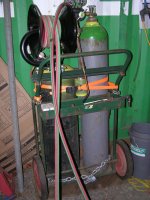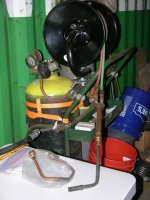If you wanna know the "why" (and you SHOULD)
Fuel your safety knowledge - acetylene
I looked into getting a rosebud for my acetylene set about 40 years ago - back then the recommendation was no more than 1/7 of tank volume per hour; if you actually READ the above link, it's now recommended no more than 1/10 of tank volume. Even at the OLD rate, I found that even the SMALLEST available rosebud (at that time) needed the LARGEST acetylene single tank you can typically find -
which is why my tank set has a 330 CF acetylene tank and about 300 CF oxy.
If you
1 - Get "brain pain" trying to figure out all the details of staying "safe", and
2 - Do NOT ever want to actually WELD with a gas torch, and
3 - Haven't already got acetylene torches...
Then I would recommend FORGETTING Acetylene and instead getting a torch setup that uses Oxygen/PROPANE - because -
Use ANY size propane tank, it'll work til it DOESN'T
If you use it a LOT, you can get 25 gallon tanks (AKA 100 pound, propane is about 4 pounds/gallon)
Still need the correct HOSES for propane (grade T hose) - the older hoses that're fine for Acetylene won't last with propane.
There are differences to be aware of, such as which part of the flame is the hottest; it's different between Acetylene and Propane, which is part of the reason there's so much negativity on the web about using propane.
Every welding shop needs an effective way to cut metal, and a simple torch cutting set up is an ideal option for many. Torch kits are more affordable than a plasma cutter and also provide the option of pre-heating metal before starting a welding project...

bakersgas.com
Here's the size tanks I use; again, BARELY big enough for serious heating or cutting -


A final note ('bout dang time :=) - the only SERIOUS reason for getting Acetylene if you're new at this is actual WELDING - Acetylene is the ONLY known fuel gas that generates it own SHIELD - NONE of the other gases do this, so if you're thinking of "going Retro", either choose Acetylene or FORGET it for gas welding.
Also, the fuel gas isn't the ONLY thing that can get you in trouble; so can Oxygen; the Fabricator link has this covered too.
Bunch of info here I know; but if you CARE about your safety, I recommend reading all the above until you REALLY understand what's involved... Steve


